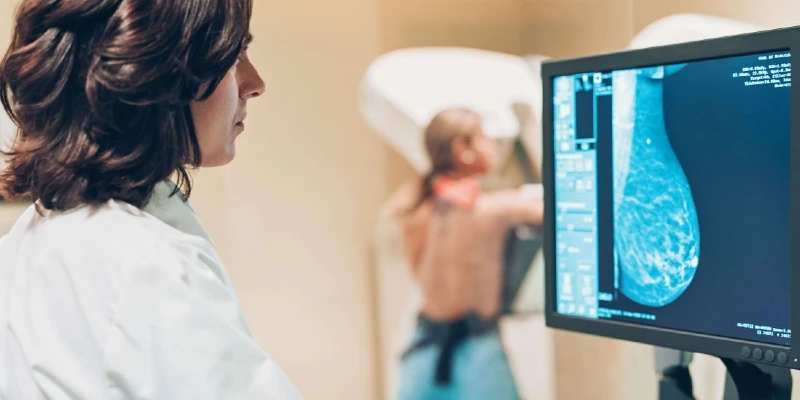This guide outlines the basics of mammogram screening, the costs of having it done, and when Medicare covers it.
Mammogram screening: overview
Breast cancer occurs when cells in the breast grow out of control. The type of cancer that affects you can be determined by determining which cells in the breast become cancerous. It is critical to understand how breast cancer develops, the symptoms, how to manage it, and the cost of the screening procedure.
The breast is composed of three distinct sections. Lobules, ducts, and connective tissue are all examples of lobules. Breast cancer can begin in these parts, but most start in the lobules and ducts. Breast cancer has the potential to spread to other parts of the body via the blood and lymphatic systems. When breast cancer spreads to other parts of the body, it has metastasized.
Breast Cancer Symptoms and Signs
Breast cancer may present with signs and symptoms or may not be present. However, those who exhibit signs and symptoms may be unique. Other than breast milk, nipple discharge may contain blood. Breast size and shape may change. Flaky skin (redness) develops in the nipple area. Breasts or portions of the breasts swell. Other signs and symptoms include pulling in and pain in the nipple area.
Mammogram and Breast Cancer Screening
Are you familiar with breast cancer screening? It is a medical procedure used to check for cancerous cells in the breast. This procedure is also known as mammography, derived from the term mammogram. A mammogram is a type of x-ray of the breast. While screening mammograms are frequently used to detect breast cancer in women who exhibit no symptoms, diagnostic mammograms are necessary when screening mammography reveals concerning findings or when specific breast cancer signals prompt the doctor to examine the tissue.
While a mammogram is only a few minutes, it can be painful and upsetting depending on your doctor’s experience, the size of your breasts, and even the sensitivity of your breasts. Further, since the process requires pressing your breasts against the machine, it can be pretty painful if not done correctly.
Breast images are generated during screening to determine the presence of breast cancer, the affected areas if cancerous cells are detected, and the stage of the condition, among other things. The doctor determines and communicates the cause of action and cost of treatment procedures based on the results.
Cost of Screening and Mammogram
The cost of a mammogram varies according to location and the services ordered by your doctor. However, the range is generally between $100 and $300. A diagnostic mammogram can be quite costly, depending on your insurance coverage.
Does Medicare cover 3D mammogram procedures? Medicare may cover a 3D mammogram depending on the beneficiary’s age bracket. Medicare covers mammograms only once in a lifetime for women between 35 and 39. It covers mammograms once a year for women over the age of 40 and diagnostic mammograms whenever necessary.
When to start screening mammograms
There is no ideal age to start screening for breast cancer. Additionally, experts and medical organizations do not agree on when women should start regular mammograms or how often tests should be performed.
Talk to your doctor about your risk factors, your preferences, and the benefits and risks of screening. Together, you can decide which screening mammogram schedule is best for you.
Some general guidelines on when to have a screening mammogram include:
- Women with an average risk of breast cancer. Many women begin mammograms at age 40 and have the exam repeated every one or two years. Professional groups differ in their recommendations. The American Cancer Society advises women at average risk to have mammograms annually from age 45 to age 54, and then continue every two years for at least the next 10 years. The US Preventive Services Task Force recommends that women begin screening every two years, starting at age 50 through age 74. However, these groups agree that women can choose to be screened starting at age 40.
- Women at high risk of breast cancer. Women at high risk of breast cancer may benefit from starting screening mammograms before age 40. Talk to your doctor about assessing your individual breast cancer risk. Your risk factors, such as a family history of or a history of precancerous breast lesions, may lead your doctor to recommend magnetic resonance imaging (MRI) in combination with mammograms.
6 frequently asked questions about mammograms
The exam raises several doubts among women, thus increasing the myths about this procedure. To clarify this matter, we separate below 6 frequently answered questions about the mammography exam.
1. When should I have my first mammogram?
Sreening performed by mammography should be started annually from the age of 40. However, in cases where the woman has family members who have had breast cancer, follow-up should begin earlier.
2. Is the radiation emitted in the mammography exam harmful?
There is contraindication for the exam only in cases of pregnancy. Other than that, mammography can be performed normally, since the radiation emitted is very low, and is insufficient to cause problems to other organs.
3. Can self-examination replace the mammography exam?
Self-examination is only the first step towards preventing breast cancer and other diseases. Therefore, it cannot replace the mammogram exam. If the presence of a cyst or nodule is noticed, the woman should visit a gynecologist or mastologist, who may request a mammogram to help with the clinical examination, allowing a detailed assessment and diagnosis.
4. Can a mammogram be performed on those who have implants or silicone prosthesis?
Yes, mammography can be performed on women with implants or prostheses. The only difference will be the performance of maneuvers to better visualize the breast tissue. In addition, it is important to clarify that compression does not cause damage to the implant or silicone prosthesis.
5. Does the mammography exam need any preparation?
To perform digital mammography, no major preparations are required. Ideally, women should schedule the exam a few days after menstruation. In this way, it is possible to avoid discomfort and sensitivity in the breasts. In addition, women should avoid using deodorant, creams or talcum powder on the breasts and armpits. These substances can interfere with the test result.
6. Can the vaccine against Covid-19 interfere with the mammography exam?
Yes, the coronavirus vaccine can interfere with an adequate result of the mammogram exam. The recommendation is that the mammogram be performed before or four weeks after the vaccine.
This is because possible confusion can occur between a common reaction caused by the immunizer and the symptoms of breast cancer. The vaccine against Covid-19 is the inoculation of particles that generate an inflammatory process in the body.
Therefore, it can cause local and regional reaction such as swelling, redness and stiffness in the arm. This type of reaction is linked to inflammation of the lymph nodes, located in the axillary and cervical region, and is a manifestation of the body’s response relatively common that happens with several other vaccines.
Final words
While breast cancer screening and mammography cannot prevent the disease, they aid in the early detection and treatment of cancer. Consult your physician to determine which tests are necessary and when they should be performed.




